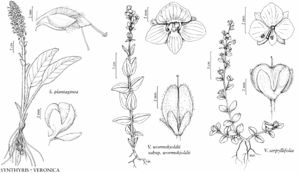Difference between revisions of "Veronica serpyllifolia"
Sp. Pl. 1: 12. 1753.
FNA>Volume Importer |
FNA>Volume Importer |
||
| Line 10: | Line 10: | ||
|special_status={{Treatment/ID/Special_status | |special_status={{Treatment/ID/Special_status | ||
|code=F | |code=F | ||
| − | |label= | + | |label=Illustrated |
}} | }} | ||
|basionyms= | |basionyms= | ||
| Line 16: | Line 16: | ||
|name=Veronica humifusa | |name=Veronica humifusa | ||
|authority=Dickson | |authority=Dickson | ||
| + | |rank=species | ||
}} {{Treatment/ID/Synonym | }} {{Treatment/ID/Synonym | ||
|name=V. serpyllifolia var. decipiens | |name=V. serpyllifolia var. decipiens | ||
|authority=B. Boivin | |authority=B. Boivin | ||
| + | |rank=variety | ||
}} {{Treatment/ID/Synonym | }} {{Treatment/ID/Synonym | ||
|name=V. serpyllifolia subsp. humifusa | |name=V. serpyllifolia subsp. humifusa | ||
|authority=(Dickson) Syme | |authority=(Dickson) Syme | ||
| + | |rank=subspecies | ||
}} {{Treatment/ID/Synonym | }} {{Treatment/ID/Synonym | ||
|name=V. serpyllifolia var. humifusa | |name=V. serpyllifolia var. humifusa | ||
|authority=(Dickson) Vahl | |authority=(Dickson) Vahl | ||
| + | |rank=variety | ||
}} {{Treatment/ID/Synonym | }} {{Treatment/ID/Synonym | ||
|name=V. tenella | |name=V. tenella | ||
|authority=Allioni | |authority=Allioni | ||
| + | |rank=species | ||
}} | }} | ||
|hierarchy=Plantaginaceae;Veronica;Veronica serpyllifolia | |hierarchy=Plantaginaceae;Veronica;Veronica serpyllifolia | ||
| Line 52: | Line 57: | ||
-->{{#Taxon: | -->{{#Taxon: | ||
name=Veronica serpyllifolia | name=Veronica serpyllifolia | ||
| − | |||
|authority=Linnaeus | |authority=Linnaeus | ||
|rank=species | |rank=species | ||
| Line 66: | Line 70: | ||
|publication title=Sp. Pl. | |publication title=Sp. Pl. | ||
|publication year=1753 | |publication year=1753 | ||
| − | |special status= | + | |special status=Illustrated |
| − | |source xml=https://jpend@bitbucket.org/aafc-mbb/fna-data-curation.git/src/ | + | |source xml=https://jpend@bitbucket.org/aafc-mbb/fna-data-curation.git/src/eaa6e58056e40c9ef614d8f47aea294977a1a5e9/coarse_grained_fna_xml/V17/V17_753.xml |
|genus=Veronica | |genus=Veronica | ||
|species=Veronica serpyllifolia | |species=Veronica serpyllifolia | ||
Revision as of 19:12, 16 December 2019
Perennials. Stems creeping to ascending, 5–40 cm, scattered eglandular hairs only, often also with glandular hairs, sometimes glabrate. Leaves: blade oblong-lanceolate to ovate, 8–25 × 5–13 mm, 1.5–2.5 times as long as wide, base cuneate, margins subentire or serrulate-crenate, apex rounded to short-acuminate, surfaces glabrate. Racemes 1, terminal, 50–100 mm, 10–30(–60)-flowered, axis eglandular- and glandular-hairy; bracts oblong, 4–7 mm. Pedicels erect, 2–5 mm, 4–6 mm in fruit, shorter than subtending bract in flower, eglandular- and, sometimes, glandular-hairy. Flowers: calyx lobes 2–3 mm, apex acute, ciliate; corolla white, blue, or pink, with purple or dark blue veins (except on abaxial lobe), rotate, 5–8 mm diam.; stamens 2.5–3 mm; style 2–4 mm. Capsules compressed in cross section, obcordiform, 2.5–3.5 × 4–5.5 mm, wider than long, apex acutely emarginate, glandular-ciliate, otherwise glabrate. Seeds 50–72, brown, ellipsoid, flat, 0.6–1.1 × 0.4–1 mm, 0.2 mm thick, smooth. 2n = 14.
Phenology: Flowering Apr–Aug.
Habitat: River banks, wet places, moist meadows, shady forests.
Elevation: 0–3300 m.
Distribution
Alta., B.C., N.B., Nfld. and Labr., N.S., Ont., P.E.I., Que., Sask., Ala., Alaska, Ariz., Ark., Calif., Colo., Conn., Del., D.C., Ga., Idaho, Ill., Ind., Iowa, Kans., Ky., Maine, Md., Mass., Mich., Minn., Mo., Mont., Nev., N.H., N.J., N.Mex., N.Y., N.C., N.Dak., Ohio, Okla., Oreg., Pa., R.I., S.C., Tenn., Utah, Vt., Va., Wash., W.Va., Wis., Wyo., Mexico (Baja California), South America, Eurasia, Australia.
Discussion
Alpine plants of Veronica serpyllifolia with bright blue, larger corollas, and smaller, hairier raceme axes have been treated at various ranks under the epithet humifusa. The characters are labile and show intergradations with the typical plants. Veronica serpyllifolia is widespread; it is not clear where it is native.
Selected References
None.
